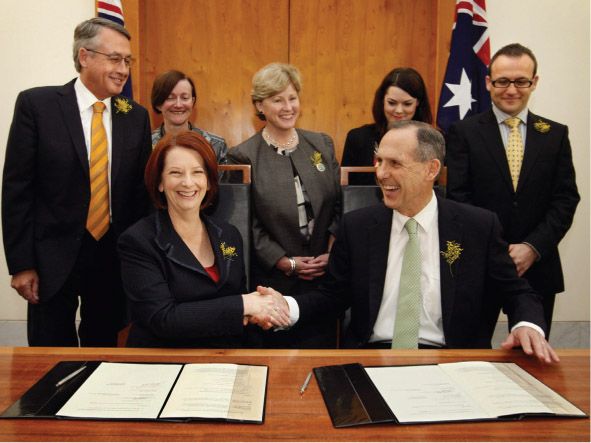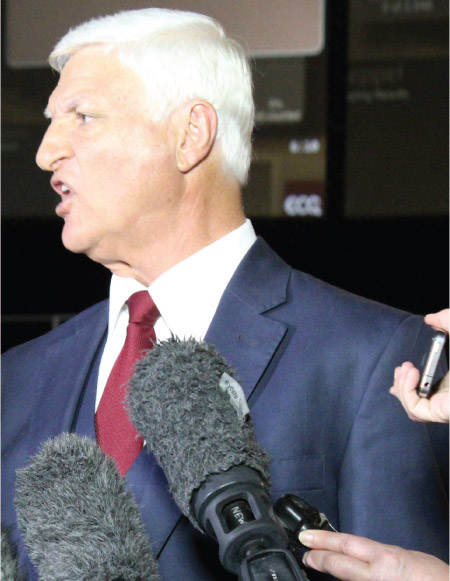Civics and Citizenship
Government and democracy
The structure of parliament
The Australian parliament is based on the principle of a representative democracy, in which every Australian citizen has the right to choose a person who will best represent their interests in political decisions. Australia is divided into electorates which are based on the number of people living within a particular area. For example, in federal politics, electorates are worked out by dividing the population of Australia into the 150 seats in the House of Representatives (also known as the lower house). There are approximately 150 000 people in each electorate, of which around 91 000 will be eligible to vote. As the electorates are based on population, some states have a large amount of electorates (Victoria has 37) and some will have fewer (Tasmania has five). The political party which wins the most amount of seats in the House of Representatives will hold a parliamentary majority.
The leader of the party with the most seats becomes the prime minister. The party which did not receive enough seats to hold a majority is called the Opposition. Sometimes there is an even division of seats between the two major political parties, with no clear winner. This is called a hung parliament. In this situation, the major political parties will try to make an arrangement with any independent members of parliament. In 2010, the Australian Labor Party (the ALP) formed a minority government with Greens member Adam Bandt and independent members to form a minority government. This meant that the Gillard government gained power not through having a majority of seats but by having support from the independent members.

Political parties in Australia
Australia has two major political parties: the Australian Labor Party (ALP) and the Coalition. The Coalition is an alliance between the Liberal Party and the National Party, the Liberal National Party and the Country Liberal Party. Traditionally, the ALP has represented the needs of workers and is considered to be more socially progressive than the Coalition. The Liberal Party has traditionally represented economic growth and traditional values. However, both parties have evolved over the decades to represent the contemporary issues and needs of Australians.
Despite the dominance of the major parties, there are many other smaller political parties in Australia. The Australian Greens is a well-known party that represents people who are concerned about the environment and are socially progressive. The Greens won the party’s first seat in the lower house in the 2010 election.
Some people choose to run for election as an independent (without a political party). For example, Bob Katter held a seat in federal parliament as an independent for 10 years before forming his political party, ‘Australia’s Katter Party’.
-

Source 9.1.2 Bob Katter held a seat in federal parliament as an independent for over 10 years. -

Source 9.1.3 The makeup of federal parliament before the 2013 federal election.
Currently, the Coalition holds 90 of the 150 seats in the lower house. As this is a majority and Australian political system follows the idea of proportional representation, the Coalition holds the parliamentary majority.
Shaping political choice
The person a citizen chooses to vote for can be influenced by lots of different factors. Strong ideological beliefs can influence a decision at an election; for example, environmental sustainability or border protection. However, the media are considered to have a significant influence on the outcome of an election. The way in which a person or a party is reported may influence the decision on the voters. The Australian media are meant to present the news without any personal biases, but some newspapers and TV stations have been accused of favouring one political party over another. Similarly, social media technology has been used as a tool to influence young voters. Many political parties include social media as part of the broader campaign. Some parties will use Facebook, YouTube and Twitter to send their political message to young voters.
DEVELOPING YOUR UNDERSTANDING 9.1.1
- Explain the terms ‘parliamentary majority’ and ‘hung parliament’ in your own words.
- Explain the federal electoral system for the House of Representatives and how a parliamentary majority can be reached.
- Conduct some research into the ALP and the Coalition and compare the parties using a Venn diagram.
- Imagine you were running for school captain or class president. Outline how you would use social media to inform your classmates of your political opinions.